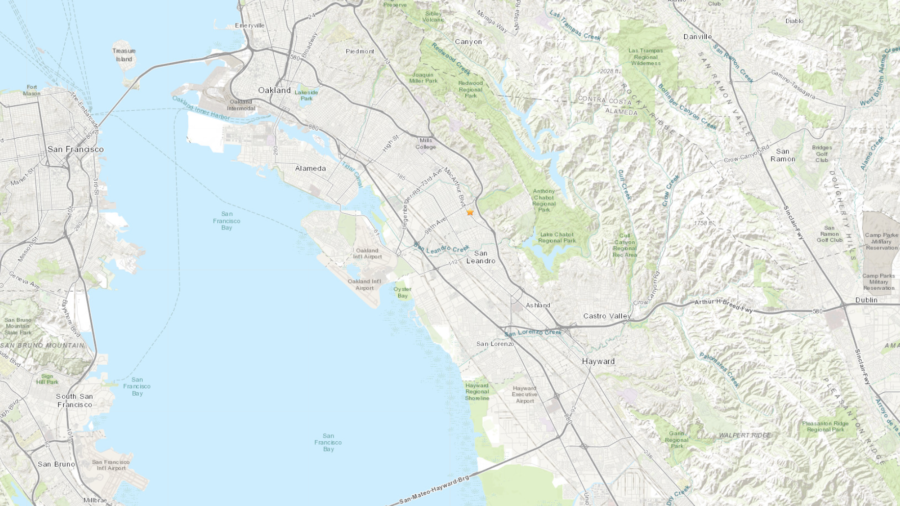The California town, San Leandro, was hit with a 2.6 magnitude earthquake on Aug. 18, according to multiple reports.
The United States Geological Survey (USGS) initially reported an earthquake originating about 1.2 miles (2 km) north of the region at around 8:25 p.m. local time with a magnitude of 2.6, according to SF Gate. The USGS report stated that the earthquake reached nearly 2.67 miles (4.3 km) deep at the time of the event. USGS is uncertain whether the above data is exact.
It was a category III intensity earthquake, and 357 people reported having felt the quake. According to the USGS, a level III intensity would result in very weak shaking with no damage.
According to SF Gate, no reports have been made of any damage or injuries resulting from the earthquake yet.
San Francisco Chronicle reported that the earthquake initially originated from the Hayward Fault. The quake’s epicenter was located somewhere a little west of the Oakland Zoo, near 99th Avenue and MacArthur Boulevard, according to the USGS.
Hayward Fault and Notable Historical Earthquakes
This fault runs from San Pablo Bay in the north to Fremont down south, according to USGS. It passes through some major cities such as Berkeley, Oakland, Hayward, and Fremont where it branches off into numerous other faults. These connect the Hayward fault with the Calaveras Fault, located in San Francisco Bay Area in Northern California.
USGS stated that this fault line doesn’t get many large earthquakes. They reported the most recent major earthquake that occurred on this fault line happened back on Oct. 21, 1868, with its epicenter located at the center of the Bay Area. At the time, 260,000 people lived in the area, making it the largest population center. The magnitude of that earthquake was unknown, but it had a devastating effect. This particular earthquake was known to the public at the time as the “Great San Francisco Earthquake,” until the great earthquake that shook San Andreas on Apr. 18, 1906 with a 7.9 magnitude.
According to the USGS, the loss that resulted from the 1868 earthquake was tremendous, with severe property damage. Also, the quake killed 30 people at the time. It was one of the most destructive earthquakes in the history of California, and it still stands as the nation’s 12th most deadly earthquake.
Southern California Hit With Swarm of 400 and More Earthquakes
A swarm of over 400 small earthquakes jolted the Inland Empire of Southern California in the last week of May, U.S. Geological Survey officials said on June 3.
Beginning on May 25, the stretch of only several square miles around Riverside County has seen at least 432 quakes. The largest one, which took place in Gen Avon on Monday around 4:30 a.m., had a magnitude of 3.2, while the smallest was around 0.8, according to USGS.
Dozens of smaller quakes also hit the area on Monday.
Experts said that they have yet to identify the cause of the earthquake swarm, but noted that the frequency of the quakes was not uncommon in the area due to the active fault lines.
“We live in an earthquake country, so these earthquakes in and of themselves are not going to cause any damage, but it’s certainly a chance for people to take a look at their emergency supplies,” Robert Graves, a researcher at the USGS, said in a press conference.
Southern California has experienced over 1.8 million small earthquakes in the past decade—about one shock every three minutes, according to a new study published in April. About 90 percent of the quakes were so small that they have slipped through the detection system’s computing algorithms.
“You don’t feel them happening all the time,” but “they’re happening all the time,” Daniel Trugman, a seismologist at Los Alamos National Laboratory who co-wrote the study, told National Public Radio.
Despite the volume of the quakes, the experts said there is no reason to panic. These small tremors that are common to the region don’t result in damage—it’s the 4 or 5 magnitude quakes and higher that need attention.
“This is the Fontana trend—a perennial hotspot of small quakes,” USGS seismologist Lucy Jones wrote on Twitter, referring to the city north of Glen Avon.
NTD Staff writer Eva Fu contributed to this article.

